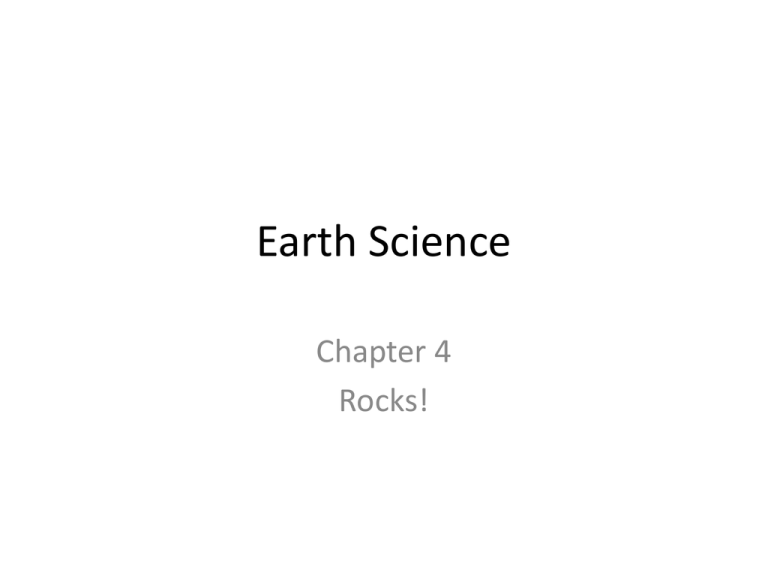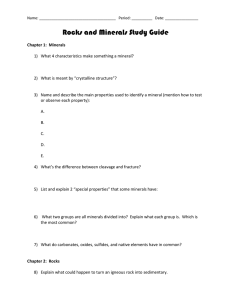Earth Science
advertisement

Earth Science Chapter 4 Rocks! Bellwork • What is the most interesting thing you learned during your research? • Write it down and then we will talk about it! Classifying Rocks • Rocks are classified using • 1. mineral composition • 2. color • 3. texture Mineral Content • Rocks can be made of one, or a combination of several minerals • There are about 20 main rockbuilding minerals One mineral Several minerals Color • Can help identify rocks • Granite is usually light • Basalt is usually dark Granite/Basalt Texture Texture Grain size Grain shape Grain pattern Grain size • Fine-some only seen with microscope • Coarse-easily seen without microscope • No visible grain-none seen even with microscope Grain pattern • Bands • Swirls • Colored bands • Random Banded Swirl Colored bands Random Bellwork • What did you find most interesting about the crystal presentations? Igneous Formation •Igneous: forms from the cooling of magma or lava Igneous formation Sedimentary formation • Sedimentary rocks form when particles of other rocks or plant/animal remains are presses and cemented together Sedimentary formation Metamorphic formation • Metamorphic formation: forms when an existing rock is changed by heat, pressure, or chemical reactions. Metamorphic formation You do it! • Read section 2 about igneous rocks. • Create a classification chart describing how igneous rocks are classified • Your chart should include information on origin, texture, and mineral composition of igneous rocks • Charts should also include illustrations, all vocabulary words, and examples of igneous rocks Igneous Rock Classification Origin On or beneath Earth’s surface Texture Depends on the size and shape of mineral crystals Mineral composition Dependent upon the amount of silica in the lava or magma Origin • Extrusive Rock: igneous rock formed from lava that erupted onto Earth’s surface • Most common type is basalt • Makes up most of the ocean’s floors Basalt Origin • Intrusive Rock: igneous rock that formed when magma hardened beneath the Earth’s surface • Most abundant intrusive rock is granite Texture • Rapid cooling=small crystals, fine grain • Slow cooling=large crystals, coarse grain • Extrusive=smooth, fine grain • Intrusive=coarse, large grain Texture Extrusive Intrusive Mineral Composition • Lava is low in silica and dark colored • Magma is high in silica and generally light colored • Geologists look at rocks under a microscope to determine the mineral makeup BELLWORK •WHAT DID YOU FIND MOST INTERESTING ABOUT IGNEOUS ROCK FORMATION? SEDIMENTARY ROCKS • READ SECTION 3 WITH A PARTNER • MAKE A FLOW CHART DESCRIBING THE FORMATION OF SEDIMENTARY ROCKS • YOUR CHART SHOULD INCLUDE: – DEFINITION OF SEDIMENT – 4 STEPS OF THE PROCESS INCLUDING EXPLANATION – ILLUSTRATIONS Sedimentary process Erosion Deposition Compaction Cementation Erosion •Natural forces break down and carry small pieces of rock Erosion Deposition •The natural processes eventually drop the eroded rock/sediment and they form layers Compaction • This presses the visible layers of sediment together Cementation • During compaction, minerals dissolve in water, fill in gaps in the sediment, and act as a glue holding the newborn rock together Cementation CLASSIFY TYPES OF SEDIMENTARY ROCKS • MAKE A CLASSIFICATION CHART DESCRIBING THE THREE MAIN TYPES OF SEDIMENTARY ROCKS • CHARTS SHOULD INCLUDE DESCRIPTION OF ALL THREE TYPES • HOW THEY FORM • EXAMPLES • ILLUSTRATIONS Classifying Sedimentary Rocks Sedimentary rocks Clastic Organic Chemical Clastic • Formed from rock fragments being squeezed together • They can be small or large rock fragments –Clay/pebbles Clastic • Most common are shale, sandstone, conglomerate, and breccia • Most form from sand on beaches, ocean floor, riverbeds, and sand dunes Shale Sandstone





